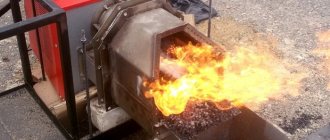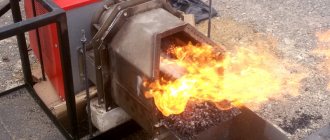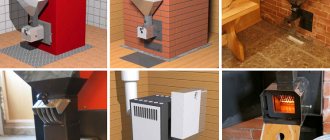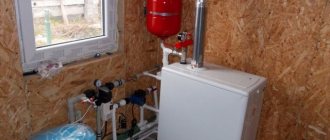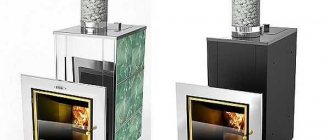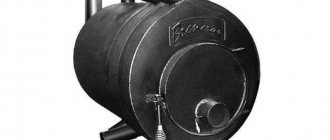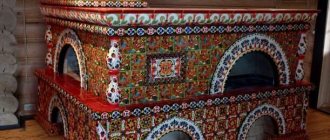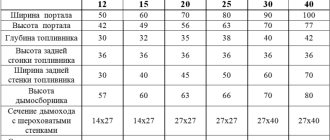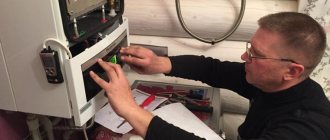Author: Yuriy Fedorovich Kolesnikov, thermal power engineer
Pellet fuel, or simply pellet, as is known, is granular waste from wood processing or agricultural production (straw, husks, etc.) pressed at elevated temperatures. The cost of heating with pellets in countries with abundant natural energy resources may be lower than with coal (excluding places directly adjacent to coal-mining regions). Pellets do not emit harmful fumes like liquid fuel, they are explosion-proof, they stain no more than firewood, but do not require wood harvesting for fuel.
At the same time, pellets are a rather capricious energy carrier; if used incorrectly, they are a fire hazard, and when searching for a DIY pellet burner there is very little useful information; They will show a torch shooting out of a nozzle, and that’s it. Or they give a diagram of a supercharged ceramic burner to a vague description of a gravitational non-volatile burner, or something else like that. This article is intended to fill this gap to some extent.
Fuel pellets and heating boilers with pellet burners
Positive Features
The described equipment has an automatic ignition system and is also fireproof. The consumer will have the opportunity to reduce costs due to the insignificant cost of pellets. Among other things, you will not need to spend additional money on maintenance. You can count on a high efficiency, and the service life of such equipment is 20 years, which will depend on the correct manufacturing and operational features. The device does not depend on central heating sources and tariffs for such services.
Product structure
Let's look at what main parts a homemade pellet burner consists of. Its task is to ensure uniform combustion of fuel and stability of the flame, due to which the water jacket of the boiler unit is heated
Particular attention is paid to the possibility of adjusting the combustion intensity
The pellet burner consists of the following elements
:
- combustion chamber (in the form of a round or rectangular pipe);
- loading hopper for fuel;
- screw conveyor for supplying bulk fuel;
- fan for forcing air into the combustion chamber.
The volume of the loading hopper determines how often the boiler operating in automatic mode will have to be serviced. The operation of the blower fan is regulated by an electronic control unit - the intensity of the air supply affects the rate of fuel combustion.
Electricity is required to operate the electronic unit, fan and screw conveyor, so this burner device is energy dependent.
Principle of operation
The pellet stove is equipped with a burner that works according to the following principle
:
- The first portion of fuel entering the combustion chamber is ignited with minimal air supply.
- During the combustion of the first portion of fuel, the air supply increases, the flame intensifies and warms up the combustion chamber.
- The fuel supply begins in small portions, the air pressure stabilizes, and the flame becomes even.
- Operation of the burner in a stable mode allows for economical fuel consumption and efficient heating of the water jacket of the boiler unit.
Design Features
The combustion chamber, made of a round or square pipe, has a tray inside for burning fuel, and on top there is a pipe with a screw conveyor for dosed supply of sawdust, granules or other fine-grained energy carriers. The chamber is attached to a flange plate, which is adjacent from the outside to the front plane of the boiler unit.
The natural flow of air does not make it possible to burn fuel in a suitable mode, so a fan is installed, turning the combustion chamber into a wind tunnel.
Dry bulk fuel with optimal air supply burns with virtually no residue. The flow of forced air carries a small amount of ash into the ash pan - that is, the combustion chamber cleans itself during operation. It is necessary to remove ashes from the ash pit once every 7-10 days - the frequency depends on the intensity of the accumulation of unburned residues. If the fuel moisture content is high, the ash pan must be cleaned more often.
Organizing the supply of bulk fuel to a homemade pellet burner is carried out in two ways
:
- A large hopper is installed in the room, into which fuel is loaded for 7-10 days of continuous operation of the boiler (it is with this frequency that the burner ash pan needs to be cleaned). To supply fuel to the burner nozzle, it is necessary to install a screw conveyor, the length of which depends on the distance between the hopper and the boiler.
- The hopper is mounted directly on the pellet burner so that bulk fuel enters the burner auger under its own weight. A gravity pellet burner is simpler and cheaper to manufacture, but it will have to be serviced more often - usually a hopper is used, the volume of which is enough for 1-3 days of boiler operation.
Positive Features
A do-it-yourself sawdust burner is a device that helps expand the functionality of a conventional solid fuel boiler. Its installation allows you to save firewood and coal if inexpensive or free waste from wood processing or crop production is available. This approach will significantly reduce the overall heating costs of a private house, cottage or garage.
Pellet burners have a number of advantages, including
:
- economical fuel consumption;
- minimum amount of ash and harmful emissions into the atmosphere due to optimization of the combustion mode - fuel and combustible gases burn almost completely;
- little need for maintenance - fuel is added no more than once a day, the ash pan is cleaned no more than once a week, the operation of the unit is automated.
Pellet burner device
Starting and maintaining the boiler
Comparison of heating costs
The equipment can be started only after installing the pellet boiler and connecting the corresponding heating system pipes to it. Once the mentioned tasks are completed, turn on the cold water supply to the heating system.
Observe the operation of the boiler. If any unusual symptoms occur, turn off the equipment and do not use it until the problem is resolved.
Observe the boiler operation
Homemade pellet boilers, like any other heating units, require appropriate care.
Every 2-3 weeks, empty the ash pan of waste. Clean the smoke exhaust duct every 2-4 weeks. This will not take you much time, but ignoring such simple maintenance will lead to a significant decrease in the efficiency of the boiler and make the equipment potentially unsafe.
If desired, additional automation equipment can be connected to the pellet boiler. This will make the operation of the equipment more convenient - you can simply forget about the need to reload fuel and other related activities for some time.
Modern automation tools even allow you to set up remote control of the heating unit, which is also very convenient.
And these are not the only possible additions. How do you like, for example, self-cleaning systems for boilers? Be sure to study the available modifications and, if desired, purchase such additions for your boiler.
Boiler with pellet hopper
You can assemble a simple pellet boiler with your own hands, following the instructions you received earlier.
Video - Operating principle of a pellet boiler
The unique smell of natural wood, a clean and decorated room in a modern style - this is exactly what a boiler room in a house can look like if you choose the right equipment. Innovative heat-generating equipment that will create the described conditions indoors is a pellet boiler or an automatic pellet burner, running on special fuel pellets, which are created from waste from agro-industrial or woodworking production.
If just a few years ago pellet installations were used in only 20% of homes in Europe, now the figure has increased to 70%. The use of pellet boilers and burners is the most beneficial option for heating a living space from an environmental and economic point of view. Today we will talk about the operating principles of the equipment, its advantages and disadvantages, and also consider a diagram for making a pellet burner with your own hands.
Automation tools
Automation requires a special control unit - the automation of a solid fuel boiler does not have the appropriate capabilities. The auger and blower motors, as well as temperature sensors, are connected to the controller. Receiving a signal from the sensors, the controller will control the operation of the engines, regulating the fuel supply and traction.
The homemade product can also be equipped with a device for automatic ignition and flame control with a photosensor, which are also controlled by the controller. The filling sensor in the fuel pipe will allow you to control the supply of bulk energy.
The use of automation equipment significantly increases the cost of the unit, but makes it as convenient to use as possible.
Automation of boiler operation using a pellet burner
Kinds
flare
Such burners for solid fuel boilers are typical mainly for Russian products. The fire rushes to the side plane. The pellets are supplied via a horizontal auger or using a vacuum tube. Draft into the boiler must be provided by force. The air pressure created by the fan is fully consistent with the needs of heating equipment; depending on the vortices that form, combustion occurs more or less stably.
Flare burners provide excellent process efficiency. You can put almost any fuel inside. In addition to pellets of various types, it is possible to use even ordinary dry wood chips that are suitable in size. The device uses the supercharging effect. Smooth adjustment is ensured by a direct connection between the fan and the automatic control system.
How to make a pellet burner with your own hands
In addition to firewood and coal, there are other types of solid fuels available to many homeowners. These are wood pellets, sawdust, seed husks, grain processing waste. Due to their granular structure, burning such fuel in the classical way is inconvenient and ineffective.
You can get more heat and automate the process by installing a special burner device on the boiler. The latter are commercially available, but they are adapted to work on pellets.
To burn husks and small sawdust, you will need an additional device; one solution is a homemade pellet burner.
DIY pellet burner
The structure of the product and the purpose of its elements
The task of any burner device is to create a powerful, even flame to heat the water jacket of the boiler, the intensity of which can be adjusted.
In this regard, the pellet burner design serves the same purpose and consists of a small combustion chamber in the form of a wind tunnel into which fuel is supplied and air is pumped.
A screw conveyor is used to feed granules or husks, and fuel enters it from a loading hopper. The volume of the latter determines the duration of the installation. Air is forced into the combustion zone from a fan - supercharger.
Screw conveyor
The combustion chamber can be either rectangular or circular in cross-section. The latter is more common because it is easier to manufacture.
If we look at the design drawings of a pellet burner, then a flat tray for burning fuel must be installed in a round chamber, and it itself is attached to a flange plate, which is adjacent to the frontal plane of the boiler from the outside.
The outer part of the device consists of a screw conveyor with an upper inlet through which fuel from the bunker enters. The second element is a fan installed under the auger and supplying air to the lower part of the chamber.
Pellet burner mechanism
Bulk solid fuels after combustion produce very little waste in the form of fugitive ash, so the design of the pellet burner provides for its self-cleaning from the air flow supplied by the blower. As a result, all the ash accumulates in the ash pan, which needs to be cleaned no more than once a week.
Description of operating modes
The very principle of operation of a pellet burner is as follows: a portion of fuel enters the chamber, it is ignited and the minimum air supply is turned on. As the fuel burns and the chamber warms up, more air is forced in. As a result, a stable, even flame appears, heating the heat exchanger with water.
In factory burner devices, the process is fully automated, ignition is provided by an electric incandescent element, and its operation is controlled by a photosensor. The amount of air and pellets supplied to the chamber is regulated by an electronic unit, receiving signals from temperature and pressure sensors.
A diagram of a pellet burner will help you understand how the device works.
https://www.youtube.com/watch?v=pkvWhUl1Nws
Fuel in the form of wood pellets or seed husks can be supplied to the pellet burner auger in various ways:
- The traditional method is to supply pellets from a separate large hopper so that its capacity is enough for at least 7 days of operation of the boiler, which needs to be cleaned once a week. From the bunker, the fuel is moved to the burner device by an additional screw conveyor of the required length.
- A DIY gravity pellet burner can be equipped with a simpler fuel supply. In it, husks and granules are poured under their own weight into an auger from a hopper installed directly above the burner device, which delivers the required amount into the combustion chamber. Then the power reserve of the boiler will be from 1 to 3 days, depending on the intensity of work.
It is not difficult to select materials for making the device. Considering the temperature regime of the combustion chamber, it is better to take a pipe made of heat-resistant steel with a wall thickness of at least 4 mm. The flange plate, with which a homemade pellet burner is attached to the body of the boiler installation, can be made of ordinary quality steel with a thickness of 3 mm.
The feed conveyor can be purchased assembled, or you can make it yourself from an ordinary pipe by placing a screw in it. For rotation, a low-speed electric motor, gearbox and bearings are selected. The fan must be purchased and fixed to the plate, preparing a seat for it.
The plate itself must be made by studying the drawings of the pellet burner, and depending on the design of the boiler door.
Pellet burner parts
Brief overview of imported products
A foreign alternative to domestic products is the Kiturami pellet burner, the list of its characteristics is as follows:
- power range – from 8 to 33 kW;
- Product efficiency is up to 95%, the overall efficiency value depends on the design of the boiler;
- remote controller;
- sensors for temperature, water level, overheating, overflow of auger with granules;
- self-cleaning grate.
The disadvantages of this device are its high cost and dependence on the reliability of the power supply. Otherwise, the product is quite reliable and does not cause any complaints; it is equipped with DRAGON KRP solid fuel installations.
Ferroli pellet burner
The Ferroli Sun P7 and Sun P12 pellet burner, which is installed on solid fuel units BUDERUS and SFL, is no less highly reliable. Maximum power is 34 and 55 kW, respectively, the set of options is the same as that of the previous manufacturer. The fan is a centrifugal type that provides a sufficient amount of air.
The imported Pelltech pellet burner has a wide range of available capacities, from 20 kW (Pelltech PV-20) to 1 MW (Pelltech PV-1000). It works well in conjunction with VIESSMANN boilers; the latter’s delivery package includes, as an option, a gas cleaning unit with a smoke exhauster; it is needed for installations with a power of over 200 kW.
Malfunctions and their elimination
To ensure trouble-free operation of a pellet boiler, it is first necessary to correctly position and install the heating equipment. The installation area must be strong, capable of supporting not only the weight of the equipment itself, but also the weight of the bunker filled with pellets.
Walls and floors must be insulated with non-combustible materials. Installation of ventilation and smoke exhaust is carried out only from non-flammable, durable and high-quality materials.
There are several relatively simple malfunctions in the operation of pellet equipment, which can easily be corrected independently:
- an increased level of fuel consumption can be caused by low-quality pellets, or a sharp drop in temperature outside;
- the appearance of sparks from the chimney pipe is most often caused by clogging of the ash pans with combustion products;
- the appearance of smoke and popping noises when opening the door of the heating boiler is usually the result of clogged fire and chimney pipes;
- Insufficient heating of the room is observed when the boiler power is incorrectly selected, the number of heating radiators is insufficient, or there is an air lock in the system.
The fashion for pellet boilers came from Germany. You can make a pellet boiler with your own hands by converting an ordinary solid fuel stove.
You will find instructions for making a potbelly stove from improvised materials here. Study and do.
As practice shows, it is advisable to purchase the most complex components and elements in ready-made form. A burner, firebox, oven doors, sensors and programmers, a fan and a factory-assembled electric motor are always preferable to do-it-yourself equipment.
Is there any point in doing this?
Often, a person who wants to install such a unit in his home is faced with the question of whether he needs to assemble a pellet stove with his own hands or whether it is best to purchase a ready-made option. It must be remembered that in the first case, a person will be able to create a unit that will fit the existing conditions in all respects, and in the second, he will have to use a structure that is ready for use, but does not take into account the individual characteristics of the room. If doubts are caused by the type of fuel used, then you need to know that pellets are a type of processed wood and agricultural waste, which makes the fuel efficient in terms of heat generation, but economical in cost. Such a homemade stove is environmentally friendly because:
- does not pollute the air;
- does not contain harmful components in vapors;
- do not require special fuel supplies, which eliminates the need to cut down trees.
After weighing all the pros and cons, a person will be able to understand whether it makes sense for him to make such a boiler with his own hands or purchase one already ready for use.
Making a pellet burner
Pellet installations are often ignored by buyers because of their high cost compared to gas and electric equipment, and the problem is solved by making the device at home.
The combustion chamber can be constructed from a square or round pipe. It is better to give preference to heat-resistant steel that can withstand elevated temperatures; the wall thickness should be at least 4 mm.
The home-made installation is fastened to the boiler using a flange plate made of heat-resistant steel with a thickness of 3 mm.
A container for supplying fuel to the combustion chamber can be purchased or made by yourself. The best option is to immediately make an installation in which fuel will be supplied automatically. To do this, place an auger in the purchased pipe of the required diameter. The rotation of the device will be carried out by a bearing, gearbox and motor operating at low speeds.
Additionally, the store can purchase a fan that will pump air. The fan is mounted on a plate, which is made depending on the size and door design of the boiler used in your home.
It is also important to take care of adjusting the amount of incoming fuel and the volume of air pumped by the fan, otherwise the homemade device will work unstably. In home devices, the air supply force and the number of pellets are adjusted manually. This method is inconvenient due to the fact that it requires constant supervision of the burner.
This method is inconvenient because it requires constant supervision of the burner.
For automation, an electrical incandescent element and a photosensor are purchased. The first device ignites the flame if the pellets go out and also regulates the switching on of the device. The photo sensor monitors the appearance of the flame: if the flame is stable, the sensor transmits a signal to the glow element to stop ignition.
To automate the system, a filling sensor is also purchased. It will notify the electronics of the device about the degree of filling of the combustion chamber with pellets.
Pellet burners are modern equipment for boilers, which can improve the environmental friendliness of the process and reduce fuel costs. At the same time, the equipment in the store itself is expensive. For basic household needs, it is better to give preference to homemade devices, the operation of which can be automated if necessary.
Preparatory activities
Before you make a homemade pellet burner with your own hands, you need to decide on the heating area of the room, this will make it possible to accurately calculate the power of the boiler equipment.
The main factors that are certainly taken into account during the calculation:
- height and size of the heated room;
- average temperature in your area;
- wall material;
- number of window and door openings.
Taking into account the reference literature, it is necessary to determine the thermal resistance coefficients of materials, and then perform heat loss calculations. The power of boiler equipment must be approximately 20 percent greater than heat losses.
If you need to independently calculate the boiler power indicators, you can use a special calculator. In this case, the error in the calculations made will be insignificant.
Gravity type devices
Gravity-type burners may not depend on electricity. The fuel enters directly into the pyrolysis chamber; pressurization can be provided thanks to the chimney draft. You can put the burner into operation manually, using one damper and a draft regulator in the chimney. But this type of device requires serious maintenance.
Non-volatile manually controlled products are only homemade. Only gravity-driven semi-automatic designs are available for sale, where fuel is supplied by means of a “self-dumper”.
To prevent fire from entering the bunker, you need to install a gateway based on elements that expand when heated, or use a double-grate design. It is movable and periodically moves back, picking up some of the pellets and transferring them to the combustion zone, while at the same time the ash is pushed into the ash pit. But there is a risk that the gap between the grates can quickly become clogged with ash. If the grate gets stuck in the rear position, fire may enter the hopper.
The diagram of a gravity-independent energy-independent burner is as follows:
- Sawdust is poured directly into the pyrolysis chamber in the form of a perforated steel basket. It is removable; a new one needs to be made for each pellet size.
- Tertiary air, which is sucked through special holes, prevents fire from entering the bunker.
- Pyrolysis of sawdust in the basket is carried out using primary air.
- In its secondary form, it enters the chamber together with gases, where combustion takes place.
- A torch of gases comes out of it.
Some factory-type burners can also be manufactured according to this design. But, unlike homemade products, they will still depend on electricity, since they have built-in automation.
Natural
Pyrolysis boilers using natural draft are preferable to forced ones at powers up to 25-30 kW. They are, naturally, cheaper, and the loss in efficiency of 5-10 percentage points in heating costs at such powers is almost not felt, but no power supply is required. You just need a chimney with good draft, at least 5-6 m high. If you plan to install a boiler to replace an old Dutch oven or an out-of-place boiler, then a natural draft boiler is the best option.
However, here too you need to choose from two different types. The first (bottom left in the figure with boiler diagrams) is with a separate supply of primary and secondary air. The second (right there) – with a single air flow.
Device
Any burner has one goal - creating a powerful flame to heat the air or water jacket of the boiler. At the same time, the combustion power itself can be adjusted independently.
A pellet burner has similar goals. The device is a wind tunnel into which solid fuel is supplied and air is pumped for combustion. Fuel is supplied to the pipe using a special screw-type conveyor. The fuel itself is located in the loading hopper before combustion. The bunker can have a different volume, and it depends on the volume how long the burner can burn on its own without human intervention (adding fuel).
Pellet burner structure: 1 - The pellet enters the burner under the influence of gravity; 2 - Air enters the burner due to the vacuum created by the draft of the chimney; 3 - Pellet combustion occurs in the combustion chamber, which is called the “basket”; 4 - Due to the high temperature, thermal decomposition of wood occurs in the basket, which forms a flow of flammable gases; 5 - A secondary air flow passes under the basket; 6 - In the burner nozzle, the flow of combustible gases and secondary air mixes, forming a torch; 7 - Solid combustion products are ejected from the burner into the ash pan of the boiler or furnace by a stream of secondary air; 8 - Ventilation of the supply channel does not allow hot gases to diffuse up the channel and destroy the pellets, ensuring a stable supply of pellets.
Air is forced into the combustion zone by means of a fan.
The combustion chamber in the burner can be round or rectangular. Round burners are the most common due to their ease of manufacture. A pipe connection is attached to the outside of the combustion chamber, through which fuel is supplied from the conveyor.
The design also includes an ash pit in which combustion waste accumulates. During the combustion of pellets, a little ash is formed, so you need to clean the ash pan no more than once a week when the burner is actively used.
There are several types of pellet burners, each of which has its own advantages and disadvantages.
Flare type
Initially, the device was used to generate heat by burning grain, but later it was converted to burn solid compressed fuel.
Side view of a flare type burner
- Small overall dimensions;
- Can be used in conjunction with boilers with a small combustion chamber;
- Simplified operation;
- Increased reliability;
- You can burn low quality pellets.
- Low power compared to other burners;
- The flame is directed horizontally, which is why it heats the boiler locally.
Volumetric type
Unlike the previous model, they have increased power and high efficiency. The disadvantages of the device include a complicated design, large overall dimensions, and dependence on the quality of the pellets used.
General view of the volumetric combustion burner
Burning pellets in a fireplace burner
Such designs are mainly used in domestic conditions, installed in fireplaces and boilers. The operating principle of the device is as follows: pellets fall into a special bowl, where they are burned under the influence of air supplied from below.
The disadvantages of the model include the size of the device and the need for precise adjustments for proper combustion.
Pyrolysis as a long-term combustion process
In a nutshell, pyrolysis is the slow burning of fuel to produce products that are again used to generate heat. The isolated atoms do not mix with each other and represent a combustible substance ready for use. The essence of combustion is a minimal supply of oxygen to maintain the smoldering of briquettes or firewood, but also a large production of thermal energy. Saving is the main advantage of the unit.
Advantages of a pyrolysis boiler
The pyrolysis boiler also has the following advantages:
- High efficiency - efficiency factor. From 85% is an excellent indicator, indicating that fuel energy is converted into heat energy with virtually no residue. For comparison, a gas boiler generates 65% of the energy.
- A boiler or pyrolysis furnace are economical units. In terms of fuel and money spent, they are in second place after the gas generator. And, of course, they are not comparable to electric boilers.
- The units process fuel in two stages - burning wood and using the released gas. The provided container for accumulating flammable gas allows you to arrange a second heating circuit with the generation of hot water for your own needs.
- Do-it-yourself long-burning boiler is a common thing, since the design is simple and you only need to have welding skills. Drawings and diagrams can be found on any network portal, as well as reviews of homemade designs.
- A do-it-yourself, long-burning solid fuel boiler that you assembled yourself does not require a permit, like gas and electric boilers. But you should not refuse the recommendations of master installers - these are, after all, high-risk units, but assembly and installation at a specific location remains the prerogative of the owner, which does not require him to make material investments in fulfilling the letter of the law.
- The time for complete combustion of one portion of fuel reaches several days. For example, a long-burning boiler for up to 7 days is a common case. This frees the owner from constant control over the unit, and its own automatic settings will allow you to leave the house with a working stove.
Automation methods
The ratio of fuel and air supply to the combustion chamber must be adjusted, otherwise the operation of the heating equipment will be unstable or constantly occur at high power.
The easiest way to change the speed of the fan and screw motor is to install a simple regulator. But in this case, there will be an added need for regular supervision and adjustment of the equipment, taking into account the ambient temperature and coolant. Setting up a heating system with your own hands consists of selecting, in different operating modes, such a ratio of air and fuel supply, during which the flame will be stable and even. This can only be achieved by automating the operation of the boiler.
First you need to purchase an electronic control unit. If the boiler is already equipped with this device, then you need to carefully study the possibilities of its use. Typically, controllers from leading manufacturers have free control contacts where electric auger and fan motors can be connected. In this case, taking into account the sensor readings, the controller will begin to increase or decrease the fuel supply and regulate the fan speed.
In terms of ignition and flame control, the burner can also be automated. It is necessary to purchase a photosensor, as well as an electronic filament element. The latter turns on at the very beginning, igniting the pellets, and the photosensor, when a persistent flame appears, will notify the controller, which will turn off the incandescent element.
A filling sensor is installed on the pipe; its main task is to send a signal to the electronic control panel if the auger is filled with pellets in order to complete the fuel supply. All these automation methods make it possible to burn fuel efficiently and create comfort during heating boiler maintenance. But there are also certain disadvantages:
- The cost of manufacturing the burner increases significantly.
- The electronic unit of the heating boiler included in the kit is usually not suitable for simultaneous operation with devices for controlling and igniting the burner; in this case, it is necessary to purchase a new one.
- The burner cannot be connected to any controller.
Safe Operation
Instructions for the safe operation of a boiler are the basis for operating personnel; without its study and practical application, people are not allowed to service any boiler, that is, for the safety of equipment and people, not only theoretical knowledge is needed from operating personnel, but also practice.
For owners who decide to install such high-tech equipment at home, practical guidance on working with a pellet boiler is provided by the organization that is responsible for the installation and commissioning of the equipment.
As a rule, the mandatory sections for operating a pellet boiler include the following sections:
- bunker maintenance, fuel filling;
- starting and stopping the boiler through the control unit;
- regulation of the combustion process, air supply;
- connecting the boiler to operation in heating and hot water modes;
- diagnostics of the operation of boiler unit components: fuel, smoke exhaust, air supply, temperature and pressure of the coolant at the inlet and outlet of the boiler, water mode;
- boiler maintenance: mechanical cleaning and ash removal;
- current and major repairs.
A pellet burner made in-house is the only effective way today to optimize an individual home heating system, especially if a solid fuel boiler is used as a source of thermal energy.
This device makes it possible to heat housing with the highest efficiency for this category of boilers.
Principle of operation
All pellet installations that can be purchased in the store are equipped with additional components:
- Auger – supplies fuel from the bunker to the combustion chamber;
- Controllers for automating the work process;
- Bunker – the place where the fuel is located before being supplied to the combustion chamber;
- A lambda probe is a special sensor that monitors the oxygen content in smoke chambers and independently controls the fuel combustion process depending on conditions.
The pellet burner must be protected with a plastic corrugated pipe. It acts as a fuse when reverse draft occurs. If the fire begins to move towards the bunker, the pipe burns out, preventing the flame from spreading.
Additionally, a fan is used, which enhances the combustion of pellets by pumping air, as well as a thermoelectric heater, which allows the fuel to be ignited without human intervention.
In automated devices, pellets are fed into the combustion chamber automatically; a person is only required to monitor the amount of fuel in the bunker. The need to supply fuel to the combustion chamber is determined using temperature sensors (they can monitor the air temperature in the room, the water temperature, or any other environmental indicators depending on the operating mode of the equipment).
The required temperature of the coolant is set by the user, all further increases and decreases are controlled using automated equipment. As soon as the temperature reaches the set level, the burner begins to operate in standby mode (the pellets do not go out, they begin to smolder). If the temperature, on the contrary, drops, the controller activates the built-in fan. Under the influence of air, the pellets flare up and the burner goes into operating mode. If during downtime the pellets go out for any reason, the heating element is activated, which re-ignites.
general description
As a rule, a standard pellet burner is sold by manufacturers already equipped with various accessories. Most often, the following items are included in the package:
- controller for automation of work;
- auger for feeding pellets;
- lambda probe, which measures the residual air volume and automatically regulates combustion;
- bunker fuel tank.
In some cases, a plastic corrugation is installed in the area from the auger to the burner, which prevents the spread of flame when reverse draft occurs. The main components of the burner are also:
- electric heating element, which is involved in automatic ignition;
- fan for air supply, located at the bottom of the device or at the back of the boiler, controlled using a controller.
In this video we will learn how to make a pellet burner with your own hands:
Automated supply of fuel from the bunker to the furnace occurs without human intervention. The pellets are fed using an electrically driven screw device, and the process is additionally checked by a controller with thermal sensors and an indication system that displays the operation of the burner itself.
The control circuit for the coolant temperature mode is simple. When the set temperature is reached, the burner, using the controller, goes into standby mode with prolonged smoldering of the fuel. Then, when the coolant cools down to a certain temperature, the sensor transmits a signal to start the fan, this causes the fuel to ignite and transfer the device to normal operation. A heating element is often used for ignition.
The efficiency of the burner will depend on the speed at which fuel is poured into the firebox and the volume of the fuel itself, therefore only the correct setting of all indicators contributes to the optimal effect of the operation of this equipment.
Pellets: what is it? Detailed fuel characteristics
This raw material is characterized by high energy intensity. It is thanks to this that it has become widespread. When processed, one kilogram of granulated pellets releases approximately 5 kW/h of heat. It follows from this that to organize the heating of a standard private house with average dimensions, you will need about 2 kg of material per hour.
Pellets for the burner are loaded into the device approximately 1-2 times a day. When loading a new portion of raw materials, it is recommended to clean the ash pan from combustion products. Store-bought burners require weekly cleaning, and homemade devices get dirty even faster. It is recommended to clean a home-made device approximately once every 3 days. Otherwise, it will fail quite quickly.
Some burner models do not require loading for 5 days. An example is the APG-42 pellet burner. This model is compatible with Teplodar-Cooper boilers.
The disadvantage of pellet burners is reverse combustion, which is accompanied by the penetration of the pyrolysis zone into the bunker intended for storing and supplying fuel. This entails smoke in the room in which the heating equipment is located, and there is also the possibility of a fire.
Pellets are small granules that are made from wood and used as fuel.
Pellets made from sawdust or any other processed waste can be blown away if there is excess air in the structure, which will lead to the generation of a large amount of waste (ash). The air supply must be clearly regulated, otherwise not only its excess, but also its deficiency can lead to ineffective operation and rapid clogging of the device.
The need for granular fuel in air is determined primarily by the combustion mode
Selecting the right regimen is a primary and very important task. The burner enters the operating mode in 5 stages
Before starting to operate the device, you must become familiar with each phase in more detail.
The first step is to ignite. The burner for a pellet boiler is ignited using a special ceramic lighter rod, which, when turned on, heats up to a very high temperature (900-1100 °C). Devices made by yourself can be ignited with an ordinary torch.
When burning, 1 kg of pellets releases approximately 5 kW/h of heat
The second stage of preparing equipment for operation is launching
It is very important to adjust the correct air supply to adjust the burner flame. Next, the device is overclocked
At this stage the burner enters normal operating mode.
After acceleration, it is necessary to adjust the air so that the correct temperature of the coolant in the return is set inside the device. Then you need to stop the supply of granular fuel and set the required air intensity.
Benefits of pellets
Pellets are biofuels obtained from peat and wood waste. Externally, these are cylindrical granules measuring 10 mm in size.
Naturally, such fuel has a number of important advantages:
- when creating granules, no chemical components are used, therefore the finished product has no odor;
- fuel absorbs moisture, so its calorific value is maintained for a long time;
- pellets are not subject to fire;
- the material does not contain dust, which can lead to allergies;
- such biofuels are considered better than coal in terms of thermal properties;
- the amount of ash is only 2% of the total volume;
- pellets require very little space, which also simplifies the transportation process;
- high efficiency;
- pellets are an economical fuel.
Work technology
Knowing the structure of a pellet burner, you can make it yourself. There are different types of homemade burner devices - it is recommended to study them and select the optimal design option.
Pellet burner drawing
Preparatory work
At the preliminary stage, detailed drawings of the device are prepared indicating the dimensions of all elements, and the necessary materials are selected.
To make a burner you need
:
- a pipe (square or round) made of heat-resistant steel, with a wall thickness of 5 mm or more - otherwise the combustion chamber will quickly burn out or deform under the influence of high temperatures;
- heat-resistant steel sheet for making a burner tray from a round pipe;
- sheet metal for making the outer casing of the device;
- sheet steel for the manufacture of a flange plate (metal thickness - from 3 mm);
- steel pipe, auger, gearbox, bearings, electric motor operating at low speeds - for the conveyor that supplies fuel to the combustion chamber;
- electric fan;
- a flexible hose for supplying fuel from a large hopper remote from the burner (connects the screw conveyor and the combustion chamber pipe);
- tools for working on metal and installing fasteners.
Installed pellet burner
Installation and configuration features
The assembly of the structure is carried out according to the drawings. The burner tube is secured in a flange plate, which is attached to the boiler casing. The open part of the burner chamber, from which the flame of fire escapes, is located inside the combustion chamber of the boiler and heats the water jacket.
Inside the burner pipe, under the nozzle, an auger is installed that supplies fuel in portions to the combustion zone. The speed of its operation must be adjusted in accordance with the intensity of the air supply. The stability of the device and the efficiency of fuel use depend on the accuracy of the settings.
Installing a manual regulator makes it possible to adjust the number of revolutions of the auger motor and blower fan. This is the simplest and cheapest solution, but you will have to constantly monitor the operation of the boiler and change the operating mode of electrical devices depending on weather conditions and the level of heating of the coolant.
One of the possible installation options
Date: September 25, 2022
